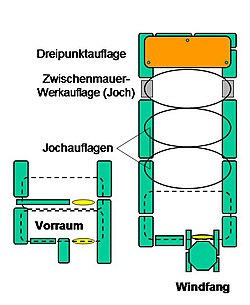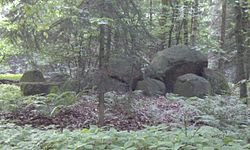Großdolmen in the Poggendorf forest
| Großdolmen in the Poggendorf forest | ||
|---|---|---|
|
Großdolmen 3 entrance |
||
|
|
||
| Coordinates | Großdolmen 3 , Großdolmen 4 , Großdolmen 6 | |
| place | Süderholz , Mecklenburg-Western Pomerania , Germany | |
| Sprockhoff no. | 525 and 526 | |
The three large dolmen in the Poggendorf forest are located in the area of the municipality of Süderholz in the district of Vorpommern-Rügen in Mecklenburg-Western Pomerania . They were excavated by Ewald Schuldt in 1969 . They have the Sprockhoff no. 525 and 526. The third system has no language number. The megalithic systems of the funnel beaker culture (TBK), arose between 3500 and 2800 BC. “Neolithic monuments are an expression of the culture and ideology of Neolithic societies. Their origin and function are considered to be the hallmarks of social development ”.
In the wider section of the approximately 10 km long Poggendorfer Forest, which lies between Schmietkow in the northwest and Sassen in the southeast, there are four systems (three have been excavated). Plant 3 is located near the north-western edge of the forest, and plant 4 and plant 6 are located near the southern edge, all of which can be reached from Sassen or Treuen.
Großdolmen 3 (Spr.-No. 525)
The large dolmen 3 ▼ is located in an approximately east-west oriented, trapezoidal barn bed about 30 m long and 11 or 7.5 m wide. Of the 46 curb stones (including the two guard stones - one preserved), 30 have been preserved. The approximately eight-meter-long chamber built diagonally at the wide end of the megalithic bed, oriented precisely north-south, with its antechamber and the entrance to the south, consists of 18 bearing stones on which there were three mighty and two smaller capstones. The 1.2 m thick southern and a split remainder lie on the chamber, one of the smaller ones is on the antechamber and one on the corridor. Further blasted remains can be found outside the enclosure.
The investigation showed that the facility is a prime example of the large dolmen with an anteroom typical of this region. Despite the damage, all structural elements inside the chamber were preserved. A 1.8 m long corridor led into an anteroom, which was led by a 1.0 m × 1.6 m red sandstone slab and a half-stone as high as a beam from the actual 6.5 m long, 2.0 m wide and 1.6 m high Chamber was separated. A quarter was found in the antechamber and one in the chamber . The planks consist of red sandstone slabs annealed flint and clay screed which is annealed red through firing . Two of the capstones have (six or four) bowls .
In addition to human bones, including seven skulls, charcoal, animal bones and corpse burn were found, and subsequent use by those who carried the individual grave culture of the Elb-Havel group and the spherical amphora culture was found. The numerous additions include 783 shards, 27 cross cutters , 22 blades , eight striking stones , six bone tools , four blade scrapers, four wide-mouthed and four double-conical vessels, four spherical amphorae, three bowls, three thick-nosed hatchets , a flat hatchet , an ax with a bent neck A narrow chisel, a drill, an arrowhead , a double ax-shaped amber bead , a barrel-shaped vessel, a tall pot, a spherical bowl and a bowl.
Großdolmen 4 (Spr.-No. 526)
The north-east-south-west oriented large dolmen ▼ in the Rollsteinhügel, built from five pairs of bearing stones, two keystones and four cap stones, is only missing one keystone and one cap stone. Two of the three existing capstones have partially collapsed into the chamber, the third lies next to it, blown up. There are 50 bowls on a bearing stone and three bowls on a cap stone . The seven meter long chamber is 1.4 m high and 2.4 or 2.0 m wide. Your hallway and the accessories were not preserved. A subsequent use by the carriers of the Globular is possible.
Großdolmen 6 (without language number)
At least one bearing stone and one keystone are missing from this large dolmen ▼ , which was also examined by E. Schuldt . Both cap stones are pushed away on the narrow sides of the chamber. No finds were made.
See also
literature
- Ewald Schuldt : The Mecklenburg megalithic graves. German Science Publishing House, Berlin 1972.
- Ernst Sprockhoff : Atlas of the megalithic tombs of Germany. Part 2: Mecklenburg - Brandenburg - Pomerania. Rudolf Habelt Verlag, Bonn 1967, pp. 77-78.
Web links
- grosssteingraeber.de: Poggendorf 1 , Poggendorf 2 , Poggendorf 3 , Poggendorf 4 , Poggendorf 5 , Poggendorf 6
- strahlen.org: Poggendorf 1 , Poggendorf 2 , Poggendorf 3 , Poggendorf 4 , Poggendorf 5 , Poggendorf 6
- megalithic.co.uk: Poggendorf 1 , Poggendorf 2 , Poggendorf 3 , Poggendorf 4 , Poggendorf 5 , Poggendorf 6





